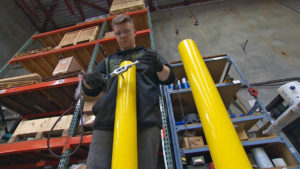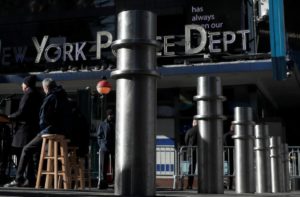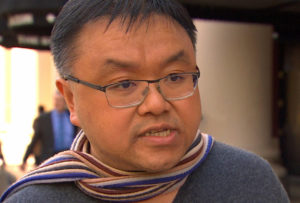Businesses and architects respond to call for better protection for pedestrians

Brad Done watched carefully as a machinist drilled a hole into a bright yellow metal tube about a metre long and 10 centimetres across at his Surrey, B.C., business, Reliance Foundry.
The pole is called a bollard, designed to be set into the ground to keep vehicles away from people and buildings.
The demand for this product is so strong it’s become the main focus of his business, which once forged metal into tools and other products for B.C. industries.
“The bollard business for us is thriving, it’s now our No. 1 sales product.”
Some bollards are just ugly metal tubes filled with concrete, Done said.
Increasingly, though, designers are looking for decorative barriers made from cast iron or stainless steel. Some serve double duty as bicycle racks.
It’s this market that Reliance is homing in on. Bollards with decorative metal covers help disguise the beefy metal and concrete barriers beneath.
“We ship product into every state in the U.S. and every province and territory in Canada,” he said on a tour of his warehouse.

“We have product in front of the Federal Reserve, Apple headquarters, Cirque du Soleil, major hotel chains, major restaurants, just about everything.”
His company alone is now selling about 15,000 bollards a year.
Attacks using vehicles on the rise
Worldwide, the number of deliberate attacks using vehicles against pedestrians has been on the rise.
Since 2006, more than 200 people have died and 1,000 injured in these attacks around the world. Most are linked to terrorism.
In New York’s Times Square, Claire Weisz an architect and urban designer, showed CBC News changes made to protect pedestrians, such as bollards and granite slabs.
“You’re looking at a Times Square today that went through a complete replanning.”
She pointed to a nearby metal pole that did its job as designed.
“When a car came through here in a deliberate act, that car was impaled over there on two of these bollards. The bollard didn’t go anywhere and the car didn’t go any further.”
Barriers have saved lives
Weisz said early attempts at improving security were often hard to look at, but more recent measures have made public spaces more attractive and functional.
“You have to have designers, artists, community members, security experts all in the room together. This simply can’t be an engineered solution.”

In Vancouver, Andy Yan ,director of the City Program at Simon Fraser University, agreed with the approach.
Standing on a busy Vancouver street, he noted that although deliberate attacks are on the increase, so are accidents.
He said urban designers have to be creative to protect people from vehicles.
Yan said concrete planters, benches and landscaping are part of the solution.
“Public art can also be about the safety of pedestrians, and something that is quiet, as opposed to something that is explicit, that I think really broadcasts fear as opposed to an element of safety.”
In New York, Weisz said the public has to understand there are limitations.
“You’re never going to come up with something that works all of the time. That’s just a fact we all have to live with.”


